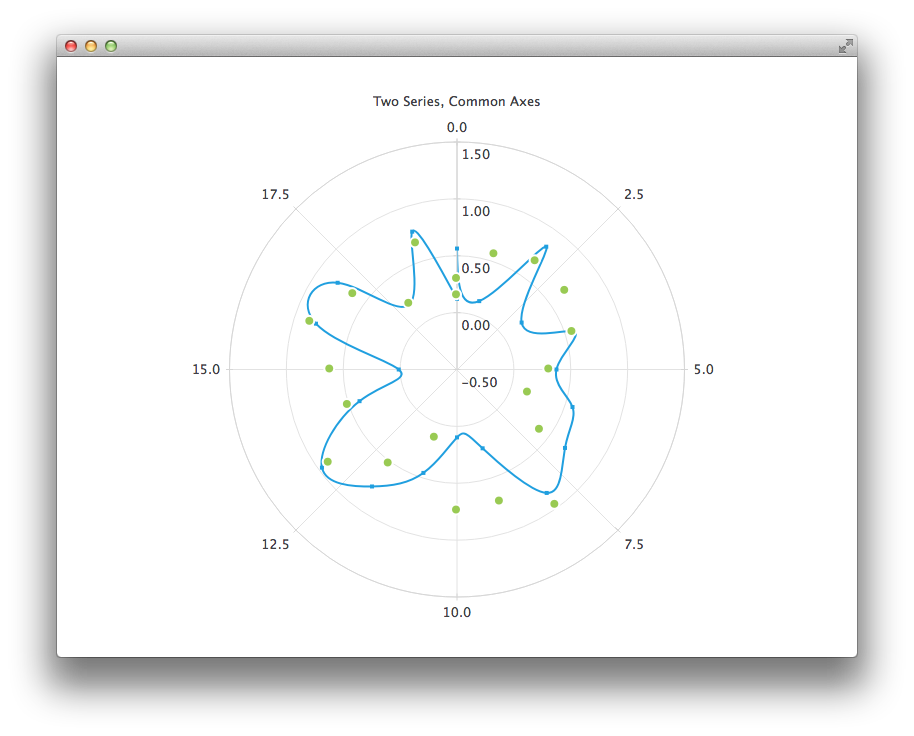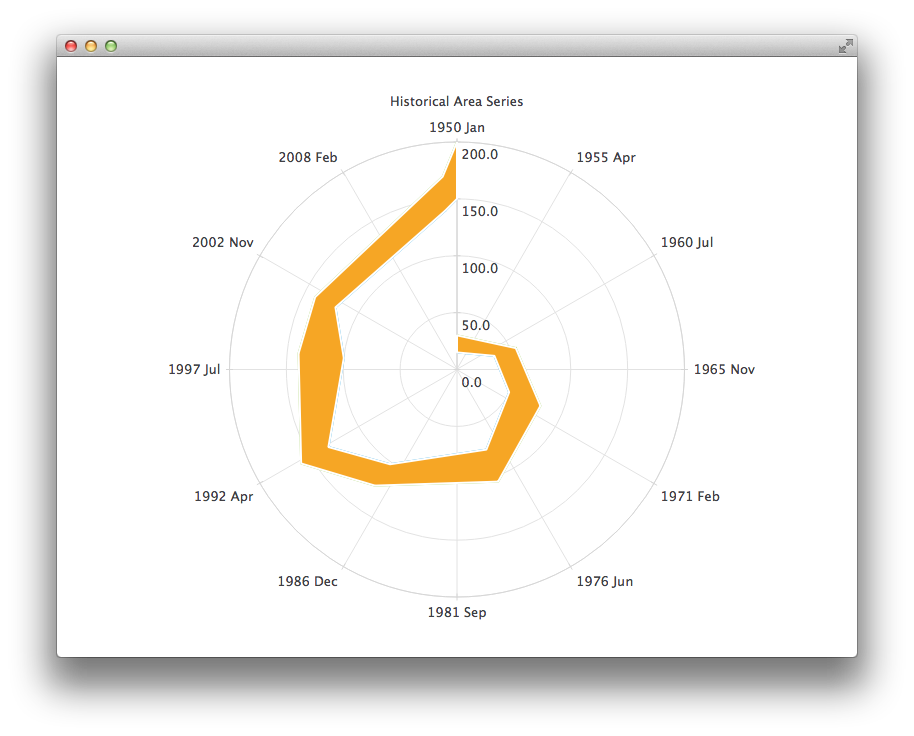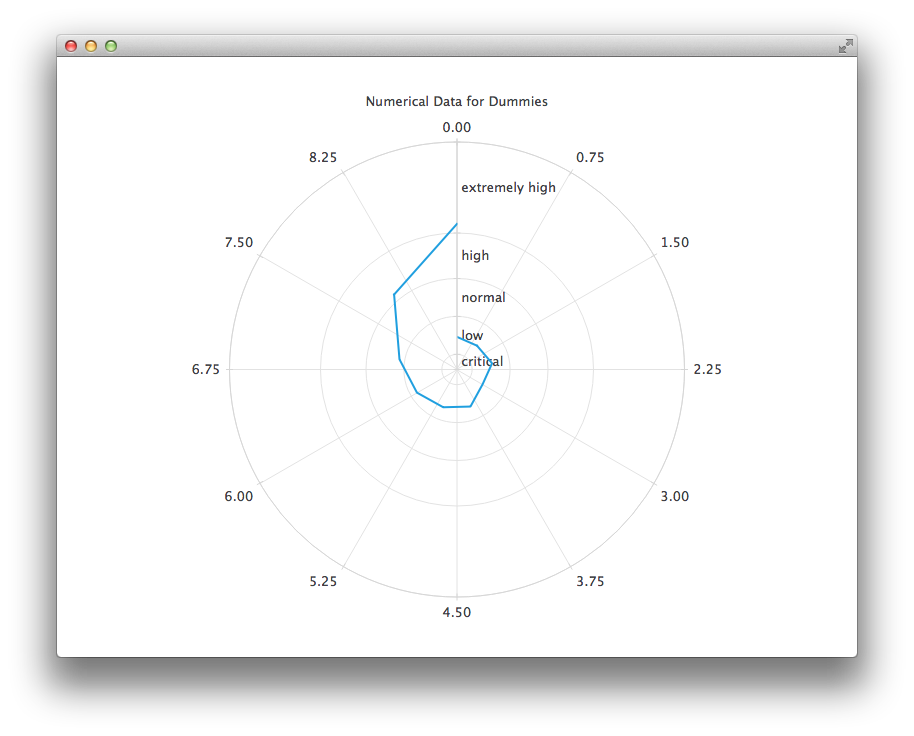QMLでポーラーチャートを使う
注: これはQMLギャラリーのCharts with QMLの例の一部です。
まず、スプライン系列とランダムデータの散布系列を持つチャートから始めます。どちらの系列も同じ軸を使っています。

PolarChartView { title: "Two Series, Common Axes" anchors.fill: parent legend.visible: false antialiasing: true ValueAxis { id: axisAngular min: 0 max: 20 tickCount: 9 } ValueAxis { id: axisRadial min: -0.5 max: 1.5 } SplineSeries { id: series1 axisAngular: axisAngular axisRadial: axisRadial pointsVisible: true } ScatterSeries { id: series2 axisAngular: axisAngular axisRadial: axisRadial markerSize: 10 } // Add data dynamically to the series Component.onCompleted: { for (var i = 0; i <= 20; i++) { series1.append(i, Math.random()); series2.append(i, Math.random()); } } }
次のチャートは、DateTimeAxis とAreaSeries を使う必要がある、正確な過去のデータを示しています。

PolarChartView { id: root title: "Historical Area Chart" anchors.fill: parent legend.visible: false antialiasing: true DateTimeAxis { id: axis1 format: "yyyy MMM" tickCount: 13 } ValueAxis { id: axis2 } LineSeries { id: lowerLine axisAngular: axis1 axisRadial: axis2 // Please note that month in JavaScript months are zero based, so 2 means March XYPoint { x: root.toMsecsSinceEpoch(new Date(1950, 0, 1)); y: 15 } XYPoint { x: root.toMsecsSinceEpoch(new Date(1962, 4, 1)); y: 35 } XYPoint { x: root.toMsecsSinceEpoch(new Date(1970, 0, 1)); y: 50 } XYPoint { x: root.toMsecsSinceEpoch(new Date(1978, 2, 1)); y: 75 } XYPoint { x: root.toMsecsSinceEpoch(new Date(1987, 11, 1)); y: 102 } XYPoint { x: root.toMsecsSinceEpoch(new Date(1992, 1, 1)); y: 132 } XYPoint { x: root.toMsecsSinceEpoch(new Date(1998, 7, 1)); y: 100 } XYPoint { x: root.toMsecsSinceEpoch(new Date(2002, 4, 1)); y: 120 } XYPoint { x: root.toMsecsSinceEpoch(new Date(2012, 8, 1)); y: 140 } XYPoint { x: root.toMsecsSinceEpoch(new Date(2013, 5, 1)); y: 150 } } LineSeries { id: upperLine axisAngular: axis1 axisRadial: axis2 // Please note that month in JavaScript months are zero based, so 2 means March XYPoint { x: root.toMsecsSinceEpoch(new Date(1950, 0, 1)); y: 30 } XYPoint { x: root.toMsecsSinceEpoch(new Date(1962, 4, 1)); y: 55 } XYPoint { x: root.toMsecsSinceEpoch(new Date(1970, 0, 1)); y: 80 } XYPoint { x: root.toMsecsSinceEpoch(new Date(1978, 2, 1)); y: 105 } XYPoint { x: root.toMsecsSinceEpoch(new Date(1987, 11, 1)); y: 125 } XYPoint { x: root.toMsecsSinceEpoch(new Date(1992, 1, 1)); y: 160 } XYPoint { x: root.toMsecsSinceEpoch(new Date(1998, 7, 1)); y: 140 } XYPoint { x: root.toMsecsSinceEpoch(new Date(2002, 4, 1)); y: 140 } XYPoint { x: root.toMsecsSinceEpoch(new Date(2012, 8, 1)); y: 170 } XYPoint { x: root.toMsecsSinceEpoch(new Date(2013, 5, 1)); y: 200 } } AreaSeries { axisAngular: axis1 axisRadial: axis2 lowerSeries: lowerLine upperSeries: upperLine } // DateTimeAxis is based on QDateTimes so we must convert our JavaScript dates to // milliseconds since epoch to make them match the DateTimeAxis values function toMsecsSinceEpoch(date) { var msecs = date.getTime(); return msecs; } }
次のチャートは、データを理解しやすくするためにCategoryAxis 。

PolarChartView { title: "Numerical Data for Dummies" anchors.fill: parent legend.visible: false antialiasing: true LineSeries { axisRadial: CategoryAxis { min: 0 max: 30 CategoryRange { label: "critical" endValue: 2 } CategoryRange { label: "low" endValue: 7 } CategoryRange { label: "normal" endValue: 12 } CategoryRange { label: "high" endValue: 18 } CategoryRange { label: "extremely high" endValue: 30 } } axisAngular: ValueAxis { tickCount: 13 } XYPoint { x: 0; y: 4.3 } XYPoint { x: 1; y: 4.1 } XYPoint { x: 2; y: 4.7 } XYPoint { x: 3; y: 3.9 } XYPoint { x: 4; y: 5.2 } XYPoint { x: 5; y: 5.3 } XYPoint { x: 6; y: 6.1 } XYPoint { x: 7; y: 7.7 } XYPoint { x: 8; y: 12.9 } XYPoint { x: 9; y: 19.2 } } }
© 2025 The Qt Company Ltd. Documentation contributions included herein are the copyrights of their respective owners. The documentation provided herein is licensed under the terms of the GNU Free Documentation License version 1.3 as published by the Free Software Foundation. Qt and respective logos are trademarks of The Qt Company Ltd. in Finland and/or other countries worldwide. All other trademarks are property of their respective owners.

